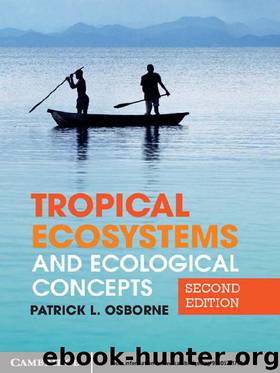Tropical Ecosystems and Ecological Concepts by Patrick Osborne

Author:Patrick Osborne [Osborne, Patrick]
Language: eng
Format: epub
ISBN: 9781139215480
Publisher: Cambridge University Press
Published: 2012-02-24T05:00:00+00:00
In tropical forests, figs provide a keystone resource. Asynchronous flowering means that figs provide a near-continuous and copious supply of nourishing fruits to birds, bats and monkeys. These animals also provide a service to the fig: seed dispersal. The seeds pass through the animal’s gut unharmed and are deposited, together with nutrient-rich faeces, on the forest floor or high in the branches of trees.
8.10 Productivity and nutrient cycling in forests
Although tropical soils are generally regarded to be highly leached, acidic and nutrient-poor, there is considerable variation between soils supporting tropical rain forests. The warm temperatures and copious rainfall found in the humid tropics promote soil weathering, and therefore minerals are continuously leached from the upper layers. These same environmental conditions also promote rapid breakdown of litter by decomposers. These weathering and recycling processes may result in the development of deep but nutrient-poor soils. However there are many exceptions. The várzea forests in the Amazon Basin grow on relatively nutrient-rich soils that are replenished each year by flooding. Rain forests in some parts of the world (e.g. Indonesia, Papua New Guinea) grow on rich, volcanic soils. In such areas, forests have been converted to intensive agriculture (oil-palm, coconut) since the soils are so nutrient-rich (see section 13.4).
Another oft-stated tenet is that most of the nutrients in tropical rain forests are tied up in the above-ground biomass. Figure 8.10 shows that there is considerable variation in the distribution of nutrients between the above-ground, forest floor and below-ground compartments. In the Brazilian lowland forest studied, most of the calcium, magnesium and potassium were found to be in the above-ground biomass but nitrogen and phosphorus were more evenly distributed between the above-ground and below-ground compartments. Notice, too, the variation between sites and the very high concentration of nitrogen in the volcanic soils in New Guinea.
Figure 8.10 Distribution of inorganic nutrients above-and below-ground in various tropical rain forests with biomass of the vegetation (after Whitmore 1984, with kind permission from Oxford University Press).
Download
This site does not store any files on its server. We only index and link to content provided by other sites. Please contact the content providers to delete copyright contents if any and email us, we'll remove relevant links or contents immediately.
The Lonely City by Olivia Laing(4768)
Animal Frequency by Melissa Alvarez(4427)
All Creatures Great and Small by James Herriot(4270)
Walking by Henry David Thoreau(3922)
Exit West by Mohsin Hamid(3795)
Origin Story: A Big History of Everything by David Christian(3666)
COSMOS by Carl Sagan(3588)
How to Read Water: Clues and Patterns from Puddles to the Sea (Natural Navigation) by Tristan Gooley(3433)
Hedgerow by John Wright(3317)
How to Read Nature by Tristan Gooley(3291)
The Inner Life of Animals by Peter Wohlleben(3285)
How to Do Nothing by Jenny Odell(3264)
Project Animal Farm: An Accidental Journey into the Secret World of Farming and the Truth About Our Food by Sonia Faruqi(3189)
Origin Story by David Christian(3170)
Water by Ian Miller(3155)
A Forest Journey by John Perlin(3043)
The Plant Messiah by Carlos Magdalena(2900)
A Wilder Time by William E. Glassley(2835)
Forests: A Very Short Introduction by Jaboury Ghazoul(2815)
